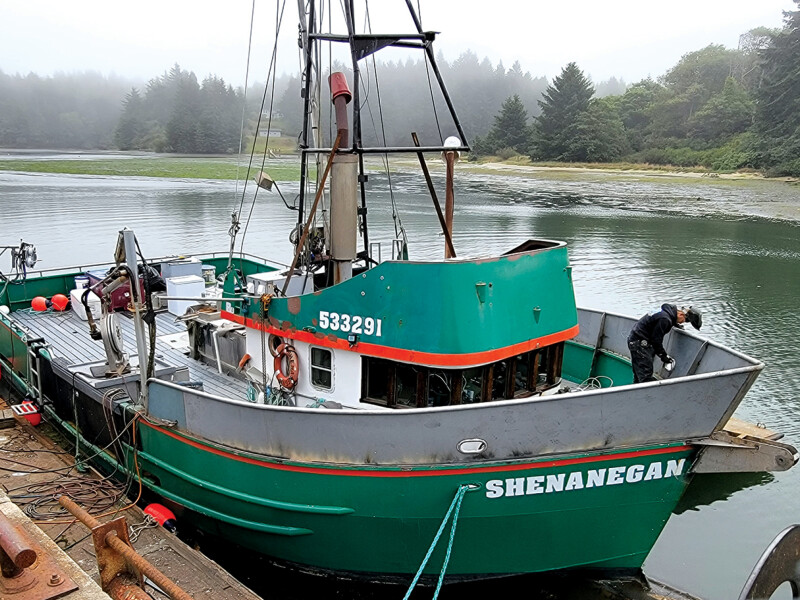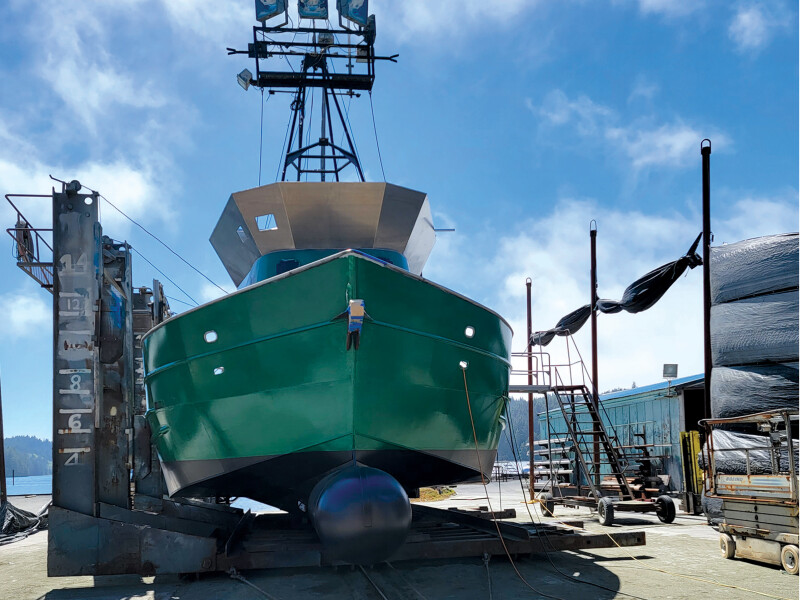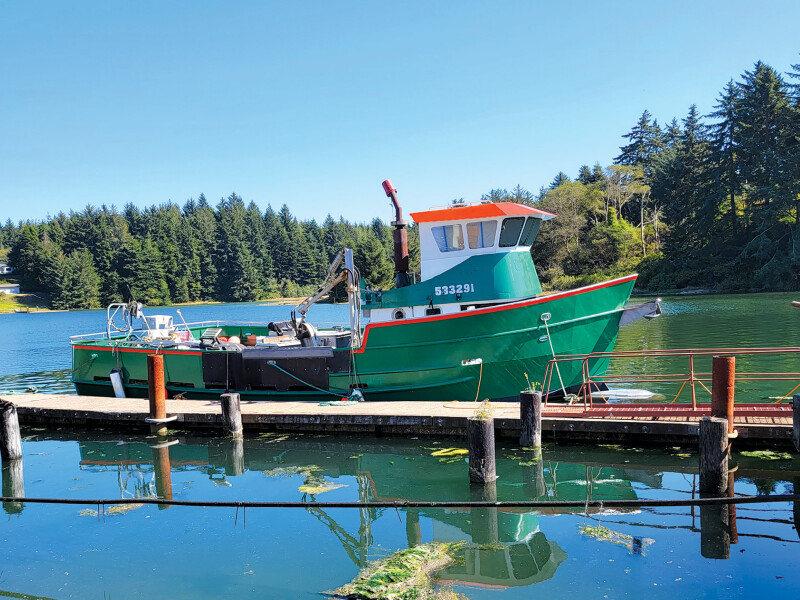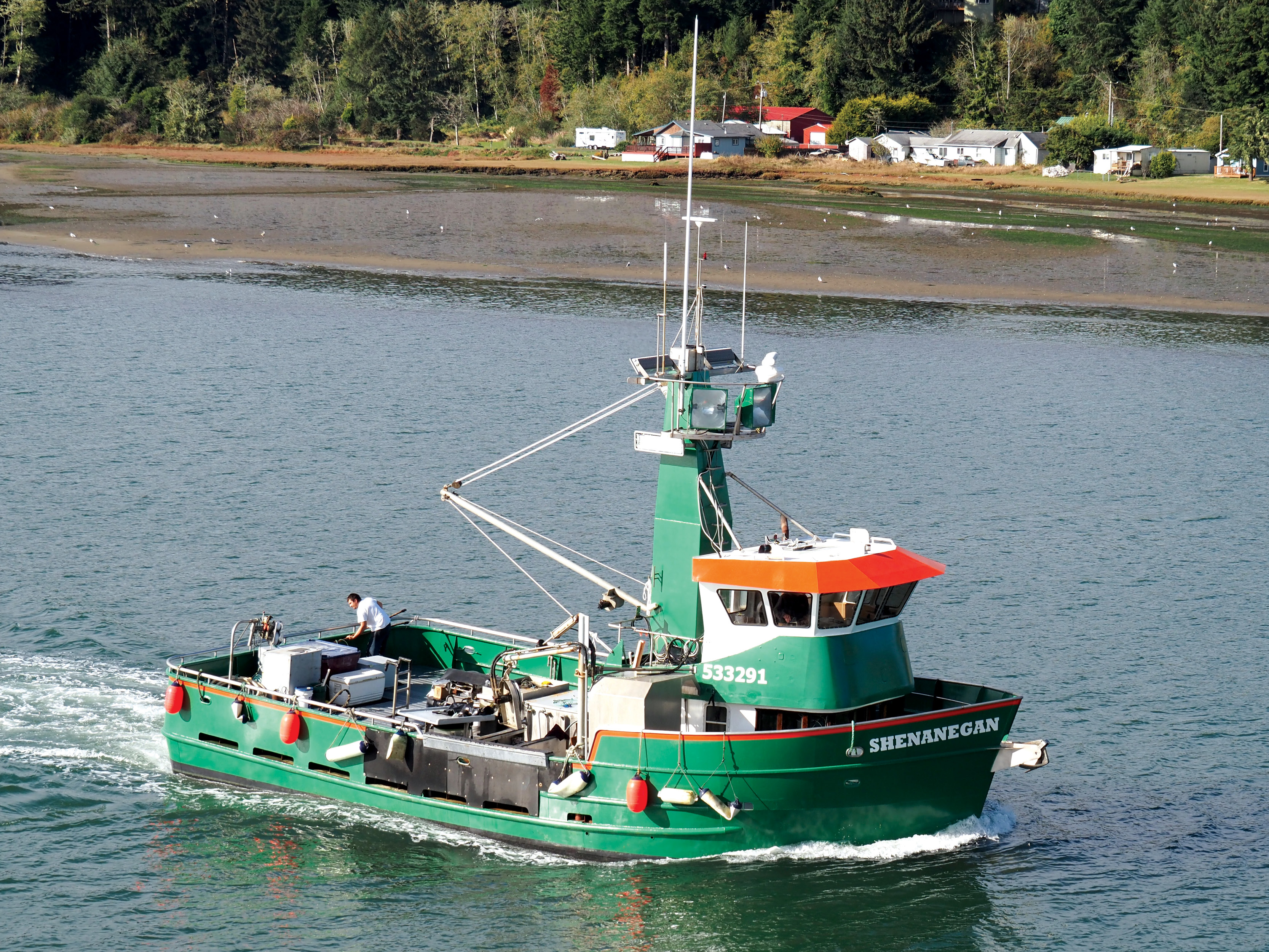The Shenanegan came down the rails in 1971 as a fairly typical 45-foot salmon troller with a beam of 14.5 feet—it drew 5.5 feet.
“She was a homemade job, made from a popular plan. But I don’t know who did it,” says owner Harry Allen. In the early 2000s Allen was fishing crab, albacore, and spot prawn and wanted a bigger boat. He bought the Shenanegan in 2007. While Allen holds dual Irish and American citizenship — his mother comes from County Donegal in Ireland — he did not name the green and orange painted boat. “I didn’t have anything to do with the name,” he says. “It was the Shenanegan when I found it.”
He took the boat straight to Giddings Boatworks in Charleston, Oregon. “First thing I did was tear it apart and widen it,” he says. “I had a design from Bruce Culver to put a whale back on it, but we didn’t get that far. We kept finding things and the project got out of control.”
Allen limited the changes that first year to widening, lengthening, and re-powering. “We added 7 and a half feet. It’s 23 feet at the widest spot,” he says. “And we added 5 feet to the stern so it’s 50 feet overall.” At Giddings, which was still being operated by Don Giddings at the time, they did the sponson work old school style, as they say. They did not use CNC files generated from a CAD program.

“They didn’t have the plate precut,” says Allen. “They just put it up, marked it, and cut it.”
With the engine room opened up and gutted, Allen had the main and auxiliary engines replaced with a John Deere 6081 and a John Deere 4045, respectively. “We re-powered again in 2013,” he says. “I put in a 400-hp, 9-liter, John Deere 6090 and a new 4045.” The new engine has a Twin Disc gear turning a 2 ¾ -inch shaft at 2:1, with a 30-inch, 4-blade propeller. “I don’t know the pitch, not much,” says Allen, who reports that the cruising speed of the Shenanegan is around 7 knots. The auxiliary runs a 36-gallon per minute hydraulic pump off the front end and the genset off the other.
The added space afforded by the lengthening and sponsons, allowed Allen to expand the tankage and fish hold. “We added four more fuel tanks,” says Allen, noting that the overall fuel capacity is now 3,200 gallons. “We put in a 700-gallon fresh water tank, and we opened up the stern to expand the fish hold. I have an 18-ton IMS refrigeration system that we also put in that year. I freeze my tuna, but the crab and spot prawn I land live, so I use that to chill the water, and I have an aerator.”
Allen also added a false deck and a few other things that first year. “The false deck is drier,” he says. “It gets you up above the scuppers.”
While Allen points out that in the long run, it would have been cheaper to do the entire project that year, but he wasn’t sure he would stay fishing. “At the time I thought I might move to Donegal,” says Allen. “I have a place there.” He’s also glad that he waited because he made changes to the original Bruce Culver design. “We never did the whaleback,” he says.
“Two years ago we put on the bulbous bow at Giddings, and that increased the speed and fuel efficiency. I get two days out of a tank instead of a day and a half.”
Allen, now 63 years old, finally went all-in on the Shenanegan in 2021. “I took it back to Giddings and we put on a new top house, a free-standing mast, and raised the bulwarks forward,” he says.
Aside from the 2007 work, Ray Cox, the current owner of Giddings, has done all the work on the Shenanegan, beginning with a shelter deck added in 2009 to protect the crew working the block when crabbing and shrimping. Ray Cox added the bulb and did the latest work. Again, when it came to the steelwork they did it all old school.
“We wanted to add 32 to 36 inches, and we just had to eyeball the angles,” says Allen. “On the stem, you have to get that just right, if you go too much it doesn’t look good. But I’m happy with it. It does what I wanted it to do, which is the water rolls up and out away from the bow. Before, it was splashing up over, especially with the bulb. The deck’s a lot drier now.”
The raised bulwarks run aft about a third of the way aft, and required allen to add a top house. “I just did a drawing of what I wanted and Ray’s son Kyle built it.”
Kyle Cox, owner of Tarheel Aluminum bolted an aluminum flange to the existing fly bridge and started tacking aluminum to it. “You have to build in place on something like that, it’s almost like sculpture,” says Cox, who has been doing aluminum work for 20 years. “There’s so much going on for angles and curves, you would need to do some very sophisticated mapping of the footprint if you wanted to build it in the shop.”

Combining math, physics, and art, Cox put together the top house that Allen had imagined. “We kind of tacked everything in place,” he says. “Then we unbolted the flange and brought it back to the shop to do all the welding so we could have some nice clean welding.” Aluminum is more trickery to weld than steel, Cox notes, and having the structure in the shop for the serious welding gave him better control of the quality of the final product. “If you can get out of the wind and the weather you can produce a better weld.”
Allen reports a lot of boats are using this kind of top with the windows angled out all around. “You see it in Ireland,” he says. “It’s great, it gives me a better view of the deck forward, so I can see my crew and what’s going on.”
The Shenanegan has four berths in the fo’c’sle and another in the original wheelhouse, and Allen usually takes three hands besides himself when crabbing. The original wheelhouse holds the galley. “It’s an old 1970s style galley,” says Allen. “We might do something with it, make it more futuristic.”
At Giddings, Allen and Ray Cox also replaced the old stick mast with a free-standing steel mast. “I have metal halide and sodium vapor lights,” says Allen, but they’re getting hard to get, so I put on LED deck lights.” Allen reports that some fishermen report issues with LED and tuna fishing. “They say the LED sends some kind of frequency through the hull that the tuna don’t like. But we’ll see this summer.”
The electronics package in the new top house includes a new Furuno radar. “It’s a solid-state Doppler radar, a Drs4D-NXT,” says Allen. “It can spot birds, for when we’re albacore fishing. As I get blinder I need that,” he says.

Considering that Bruce Culver’s original engineering involved considerable additions of steel above the deck, it also included some stability analysis. But Allen notes that having skipped the whaleback idea, the new design is considerably lighter, and well within the parameters of Culver’s earlier stability work.
With the completion of the latest work, Allen finally has the boat he’s been imagining and refining in his imagination for 14 years. “This boat’s always been a work in progress,” says Allen. “But there’s not much more you’d need to do. I did a lot of this work thinking about the resale value.”
With ample deck space, refrigeration, power, and many upgrades, the Harry Allen has turned the Shenanegan into a well-functioning and versatile fishing machine that he plans to eventually sell and then retire to Ireland. “I fished there for 6 months in 2000,” he says. “I might try that again.”








.jpg.small.400x400.jpg)